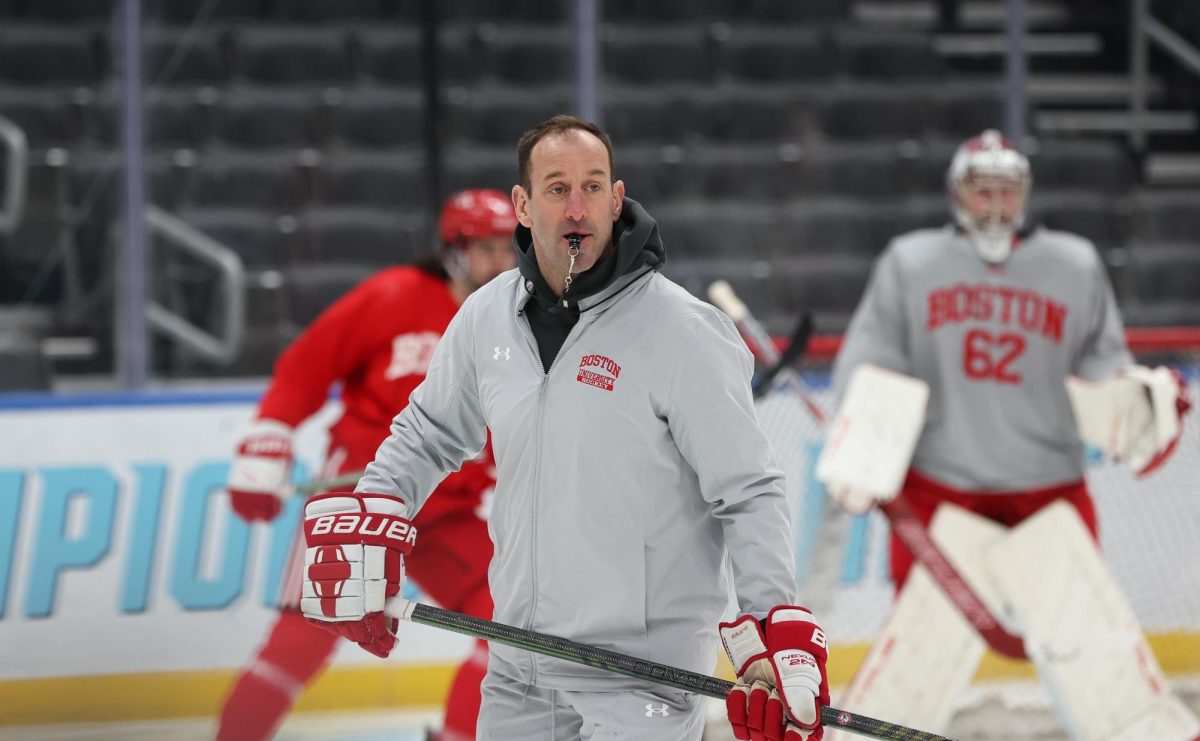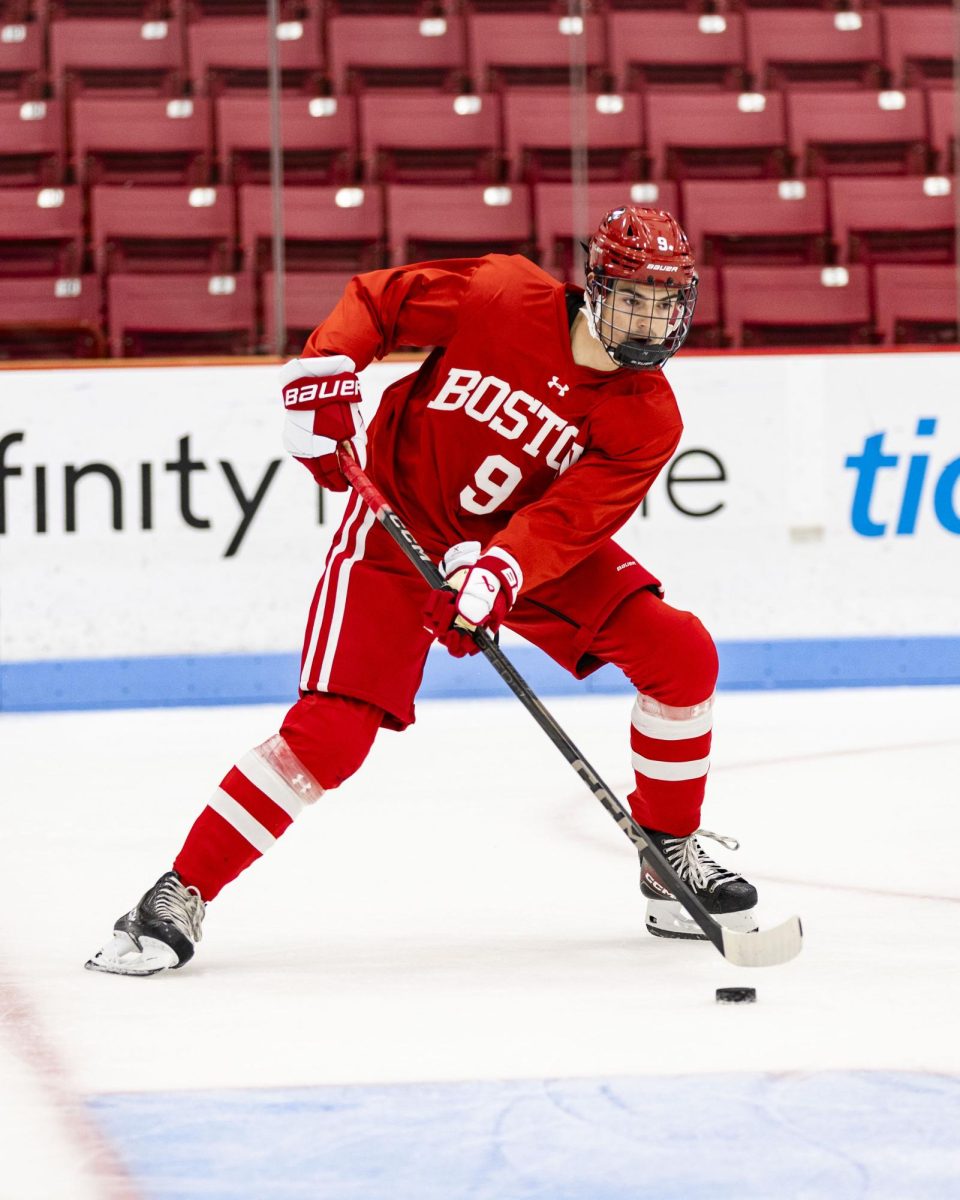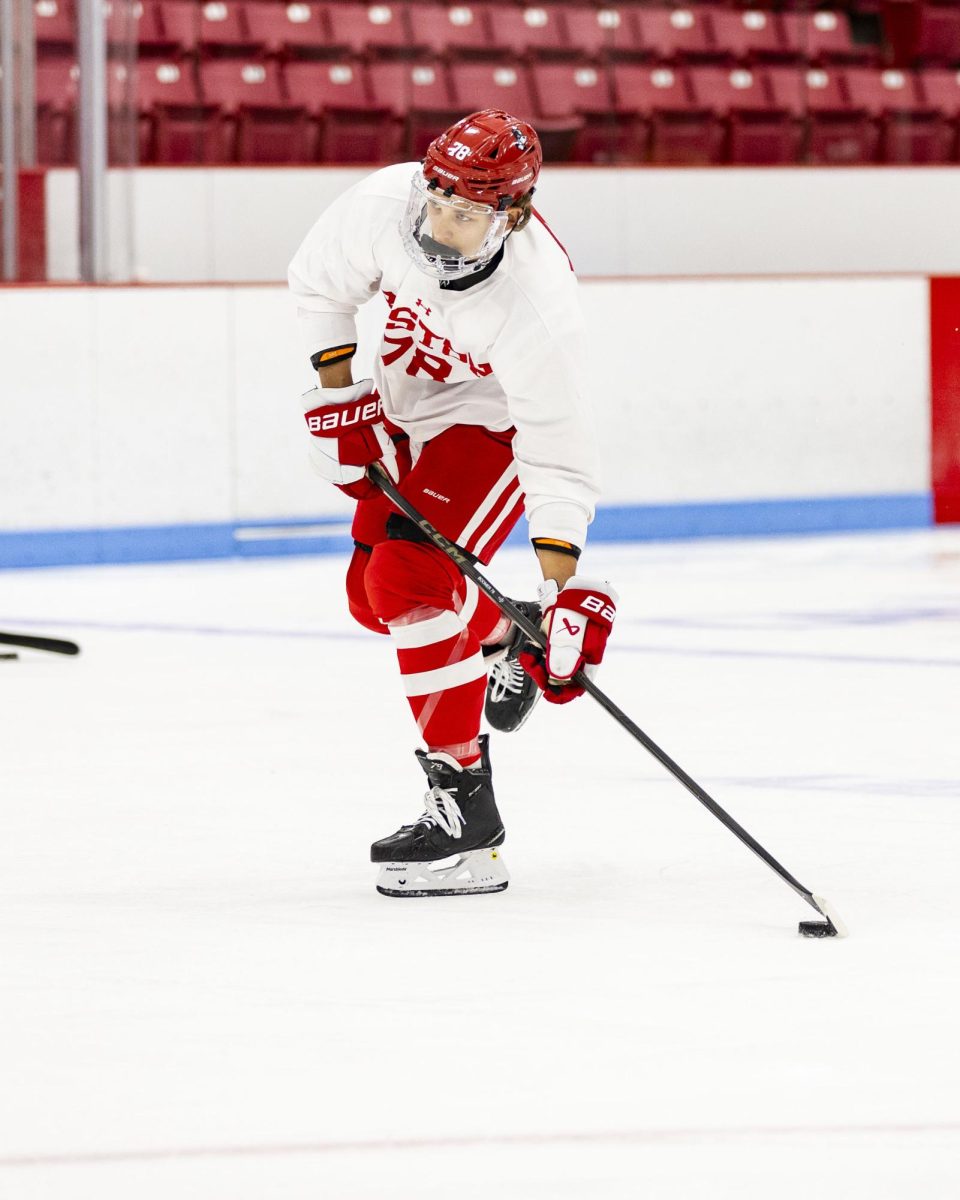
Rich Gagnon
BOSTON UNIVERSITY MEN’S HOCKEY has a rich history. Its tradition dates to the program’s first game in 1918, and there are five national championship banners hanging from the ceiling at Agganis Arena to show for it. But it’s been over 15 years since one’s been raised, despite contending annually. Still, year after year, the best players choose to bear the Scarlett and White.
Why? It’s because playing for BU is a springboard to playing professional hockey. Head coach Jay Pandolfo — who himself was a Terrier and had a long NHL career — says that the goal of “almost 100 percent” of players who come to BU is to reach the NHL.
On April 17, Devin Kaplan, a former three-year player, became the 100th former Terrier to play in an NHL game. That number trails only Minnesota, Michigan, and North Dakota. Additionally, 28 former Terriers played during the 2024-25 season, trailing only the Wolverines.
That is why BU is a destination in college hockey. It’s the player development capital of NCAA men’s hockey on the East Coast.
But what exactly is player development?
When a player is drafted, they aren’t picked for what they are; they are selected for what they could become. Organizations are projecting what 18-year-olds will blossom into years down the line. After being selected, the next two-plus years are crucial in a player’s development, but there isn’t one set way to go about it because it’s not an exact science.
Ask anyone in hockey, “What is development?” or “How do you categorize development?” They’ll either pause to think or struggle to muster an answer. In interviews with the Boston Hockey Blog, NHL executives were asked those two questions.
“It’s not an easy question to answer,” Mike Grier, the general manager of the San Jose Sharks, said. “There’s all different ways for players to develop, and no player’s path or trajectory is the same.”

WITH THE NCAA-CHL AGREEMENT — which allowed Canadian major junior players to play collegiately — now fully in effect, every top player in a given birth year can consider playing college hockey, an option that didn’t exist a year ago.
Chris Kelleher, the assistant general manager of the Minnesota Wild, says the right college program is a place where a given player can succeed in more ways than just on the ice.
“The big programs and a lot of the college programs now, they have everything,” he said. ”If you’re driven and you want to succeed, they’ll give you every opportunity.”
That’s precisely why, since the landmark agreement on Nov. 7, 2024, a number of top prospects and draft-eligible players have made the move to the NCAA. Penn State brought in Gavin McKenna, the projected top pick in the 2026 class, and the 2025 14th overall pick, Jackson Smith. Michigan State added 2024 fourth overall pick Cayden Lindstrom and 2025 sixth overall pick Porter Martone. Hockey East rival Providence added 2025 10th overall pick Roger McQueen. While BU didn’t add a CHL player of the caliber of those previously listed, it added Ryder Ritchie, a second-round selection of the Wild in 2024.
“We feel it’s a great spot for him,” Kelleher said of Ritchie choosing to play for the Terriers.
The college hockey schedule is very different from that of the CHL. The OHL and WHL have 68-game regular season games, while the QMJHL has 64, which was moved down from 68 to “optimize our players’ development both on and off the ice,” said commissioner Mario Cecchini. The vast majority of NCAA programs don’t play more than 40 games, both regular and postseason. Pandolfo feels the NHL values the college hockey schedule.
“There’s a lot of practice time, a lot of time to develop off the ice, in the weight room, and that’s a lot of what these kids need at that age,” he said.
With Ritchie specifically, Pandolfo said he’s going to benefit from playing fewer games and not taking long bus rides to travel to away games.
“You just don’t have as much time to train off the ice [in the CHL]. So I think that’s really going to benefit him,” he added. “He’s a really good-sized kid, but he’s still going to develop off the ice as well. And with the skill set he has on the ice, I think it’s really going to help him. I think you’re going to see him get a lot better over the course of the season.”

PANDOLFO, HAVING PLAYED AT BU from 1992 to 1996 and now having coached at his alma mater since 2021, knows better than anyone how valuable the university can be for a young player.
“This place creates a great environment for players to develop, to win, and to learn how to be a pro,” he said. “That goes a long way, and I think that’s why NHL teams value what BU hockey is all about.”
Grier and Kelleher played with Pandolfo at BU, and now with decades of experience in and around NHL front offices, they know everyone else around the league feels the same as they do.
“[Wild general manager] Bill Guerin’s a BC guy, but he thinks the world of Jay Pandolfo and BU,” Kelleher said. “Any team would be happy to see their guys go there and develop and have a great college experience. It’s a widely, widely respected, highly respected program amongst NHL personnel.”
For Grier, it all starts with Pandolfo and the rest of the staff: associate head coach Joe Pereira and assistant coach Kim Brandvold.
It’s rare in college hockey that anyone on a coaching staff has experience coaching at the NHL level. The Terriers have two in Pandolfo and Brandvold. Pandolfo spent a season with the New Jersey Devils as a scout and then seven seasons with the Boston Bruins, working his way up to an assistant coach. Brandvold also spent seven seasons with the Bruins as a skating consultant and a skating and skills development coach.
“They spent a lot of time in the NHL, working with NHL players, working in NHL systems, and knowing what NHL habits look like,” Grier said. “They have that to be able to fall back on and teach these kids and help guide these kids to what it actually takes to not only play in the NHL, but to be successful in the NHL. I think for kids, that’s something I’m sure is very exciting, and it’s a big plus, because it’s one thing to play a handful of games in the NHL, but you want to get to the NHL and make a career out of it.”
Kelleher added: “That’s what Jay and Kim can bring to these young kids. It’s like, ‘Hey, we saw it firsthand with [Patrice] Bergeron, [Brad] Marchand,’ whoever they worked with. This is what they do, and they’re still some of the best players in the world, and they do it every day.”
Pandolfo and Brandvold are two great hockey minds. Grier talks to Pandolfo often, and not just to catch up, but also to pick his brain on the game and players he’s either seen or coached. Grier says he enjoys picking Brandvold’s brain on skating because he’s “got a really good eye for that.”
Brandvold is an extremely valuable asset to BU. He’s got loads of experience developing players, whether it’s a full skill set or little things that prove to be valuable over the course of a long professional career, Pandolfo said. He’s spent years with the best players in the world.
“He’s spent a lot of time with Jack Eichel. He has spent a lot of time with great players in Boston. He has that experience,” Pandolfo added. “He’s very comfortable working with the top players. He’s confident in what he does. I think players feel that too, and I think that goes a long way.”
Pereira, who doesn’t have experience coaching at the NHL level, says he’s learned a great deal from Pandolfo and Brandvold. Players trust what they’re saying because they have the experience and the resume to back it up. He added that their strength and conditioning coach, Ken Whittier, has “15-20” NHLers in the weight room at BU training every day over the summer.
“I think it speaks to what our model is, and it’s obviously working,” Pereira said.
Just ask juniors Gavin McCarthy, Jack Harvey, and Ritchie.
“You trust them with your development. They’ve seen it all. They’ve been through the ranks of the NHL, and honestly, I couldn’t have more trust in them and what they’re doing with us,” McCarthy said.
“They know what guys in the NHL are doing and what it takes and what they’re doing to get themselves ready,” Harvey added. “You really trust what they’re telling you and the information that they’re giving you.”
“When you have a coaching staff like that, you’re a step ahead,” Richie said.
But like Grier, Pandolfo knows that development is up to the player. There is only so much coaches and facilities can provide, despite BU having everything a player could need.
“We want to develop winning players. We want to teach them how to play the game the right way. We want to make sure they’re acting the right way, not only on the ice, but off the ice. All those things combined, I feel like that’s development,” Pandolfo said.
Editor’s note: This story is part of the Daily Free Press’ annual Hockey Issue. Physical copies are available around campus starting Friday, October 3rd and will be handed out at both the men’s and women’s home openers.